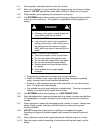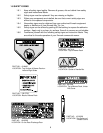
12
FIGURE 4
c) Move the throttle-choke control to the
(Choke) position.
NOTE: Do not use the choke when the engine is warm.
d) Pull the starter handle lightly until you feel resistance, then pull it sharply.
Allow the rope to return slowly.
e) When the engine starts, move the throttle control to the Fast position, and set
the ground speed control as desired.
NOTE: If the engine fails to start after 3 pulls, repeat steps 3-6.
3.3.3 Stopping the Engine
:
Release the blade control bail. The blade should stop within 3 seconds. Move the
throttle to the (Off) position to kill the engine.
NOTE: If the blade does not stop within 3 seconds after releasing the blade
control bail, contact an Authorized Service Dealer.
3.3.4 Using the Self-Propel Drive
:
The lawn mower has three ground speeds. 1 is slow, 2 is medium, and 3 is fast
(See Figure 1 for speed control lever location).
a) Start the engine.
b) Using the ground speed control, select the desired ground speed.
c) Squeeze the drive bail against the handle (See Figure 1).
NOTE: Do not shift speeds while squeezing the ground speed control against
the handle. This can damage the transmission. Release the ground speed
control before changing speeds.
NOTE: You can vary the ground speed by increasing or decreasing the
distance between the ground speed control and the handle. Lower the control
bar to decrease the ground speed when you are making a turn or if the lawn
mower is moving too fast for you. If you lower the control bar too far the lawn
mower stops self-propelling. Squeeze the ground speed control closer to the
handle to increase the ground speed. When you hold the ground speed control
tight against the handle, the lawn mower self-propels at the maximum ground
speed. Move the ground speed control to the Neutral position when you use
the lawn mower for trimming or whenever you leave the lawn mower.
3.3.5 Operating the Blade Control Lever
:
a) Start the engine.
b) Squeeze the blade control bail against the handle (Figure 1).
c) Move the blade control lever to the full forward Latch position. Blades should
engage (Figure 1).
d) Release the blade control bail to disengage the blades.


















